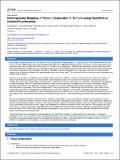Files in this item
Heterogeneity mapping of protein expression in tumors using quantitative immunofluorescence
Item metadata
| dc.contributor.author | Faratian, Dana | |
| dc.contributor.author | Christiansen, Jason | |
| dc.contributor.author | Gustavson, Mark | |
| dc.contributor.author | Jones, Christine | |
| dc.contributor.author | Scott, Christopher | |
| dc.contributor.author | Um, InHwa | |
| dc.contributor.author | Harrison, David J | |
| dc.date.accessioned | 2015-03-13T16:01:04Z | |
| dc.date.available | 2015-03-13T16:01:04Z | |
| dc.date.issued | 2011-10-25 | |
| dc.identifier | 173396968 | |
| dc.identifier | 2ec7773e-9eec-4fe8-ae6a-c745aaf94aac | |
| dc.identifier | 84858407584 | |
| dc.identifier.citation | Faratian , D , Christiansen , J , Gustavson , M , Jones , C , Scott , C , Um , I & Harrison , D J 2011 , ' Heterogeneity mapping of protein expression in tumors using quantitative immunofluorescence ' , Journal of Visualized Experiments , vol. 56 , e3334 . https://doi.org/10.3791/3334 | en |
| dc.identifier.other | RIS: urn:98BA59E1CD1BCA84C5AA22552E18D70E | |
| dc.identifier.other | ORCID: /0000-0001-9041-9988/work/64034281 | |
| dc.identifier.uri | https://hdl.handle.net/10023/6233 | |
| dc.description.abstract | Morphologic heterogeneity within an individual tumor is well-recognized by histopathologists in surgical practice. While this often takes the form of areas of distinct differentiation into recognized histological subtypes, or different pathological grade, often there are more subtle differences in phenotype which defy accurate classification (Figure 1). Ultimately, since morphology is dictated by the underlying molecular phenotype, areas with visible differences are likely to be accompanied by differences in the expression of proteins which orchestrate cellular function and behavior, and therefore, appearance. The significance of visible and invisible (molecular) heterogeneity for prognosis is unknown, but recent evidence suggests that, at least at the genetic level, heterogeneity exists in the primary tumor(1,2), and some of these sub-clones give rise to metastatic (and therefore lethal) disease. Moreover, some proteins are measured as biomarkers because they are the targets of therapy (for instance ER and HER2 for tamoxifen and trastuzumab (Herceptin), respectively). If these proteins show variable expression within a tumor then therapeutic responses may also be variable. The widely used histopathologic scoring schemes for immunohistochemistry either ignore, or numerically homogenize the quantification of protein expression. Similarly, in destructive techniques, where the tumor samples are homogenized (such as gene expression profiling), quantitative information can be elucidated, but spatial information is lost. Genetic heterogeneity mapping approaches in pancreatic cancer have relied either on generation of a single cell suspension(3), or on macrodissection(4). A recent study has used quantum dots in order to map morphologic and molecular heterogeneity in prostate cancer tissue(5), providing proof of principle that morphology and molecular mapping is feasible, but falling short of quantifying the heterogeneity. Since immunohistochemistry is, at best, only semi-quantitative and subject to intra- and inter-observer bias, more sensitive and quantitative methodologies are required in order to accurately map and quantify tissue heterogeneity in situ. We have developed and applied an experimental and statistical methodology in order to systematically quantify the heterogeneity of protein expression in whole tissue sections of tumors, based on the Automated QUantitative Analysis (AQUA) system(6). Tissue sections are labeled with specific antibodies directed against cytokeratins and targets of interest, coupled to fluorophore-labeled secondary antibodies. Slides are imaged using a whole-slide fluorescence scanner. Images are subdivided into hundreds to thousands of tiles, and each tile is then assigned an AQUA score which is a measure of protein concentration within the epithelial (tumor) component of the tissue. Heatmaps are generated to represent tissue expression of the proteins and a heterogeneity score assigned, using a statistical measure of heterogeneity originally used in ecology, based on the Simpson's biodiversity index(7). To date there have been no attempts to systematically map and quantify this variability in tandem with protein expression, in histological preparations. Here, we illustrate the first use of the method applied to ER and HER2 biomarker expression in ovarian cancer. Using this method paves the way for analyzing heterogeneity as an independent variable in studies of biomarker expression in translational studies, in order to establish the significance of heterogeneity in prognosis and prediction of responses to therapy. | |
| dc.format.extent | 7 | |
| dc.format.extent | 363329 | |
| dc.language.iso | eng | |
| dc.relation.ispartof | Journal of Visualized Experiments | en |
| dc.rights | Copyright © 2011 Creative Commons Attribution-NonCommercial License. This is an open-access article distributed under the terms of the Creative Commons Attribution License, which permits unrestricted use, distribution, and reproduction in any medium, provided the original work is properly cited | en |
| dc.subject | Quantitative immunofluorescence | en |
| dc.subject | Heterogeneity | en |
| dc.subject | Cancer | en |
| dc.subject | Biomarker | en |
| dc.subject | Targeted therapy | en |
| dc.subject | Immunohistochemistry | en |
| dc.subject | Proteomics | en |
| dc.subject | Histopathology | en |
| dc.subject | R Medicine | en |
| dc.subject | SDG 3 - Good Health and Well-being | en |
| dc.subject.lcc | R | en |
| dc.title | Heterogeneity mapping of protein expression in tumors using quantitative immunofluorescence | en |
| dc.type | Journal article | en |
| dc.contributor.institution | University of St Andrews.School of Medicine | en |
| dc.identifier.doi | 10.3791/3334 | |
| dc.description.status | Peer reviewed | en |
| dc.identifier.url | http://www.jove.com/video/3334/heterogeneity-mapping-protein-expression-tumors-using-quantitative?id=3334 | en |
This item appears in the following Collection(s)
Items in the St Andrews Research Repository are protected by copyright, with all rights reserved, unless otherwise indicated.

